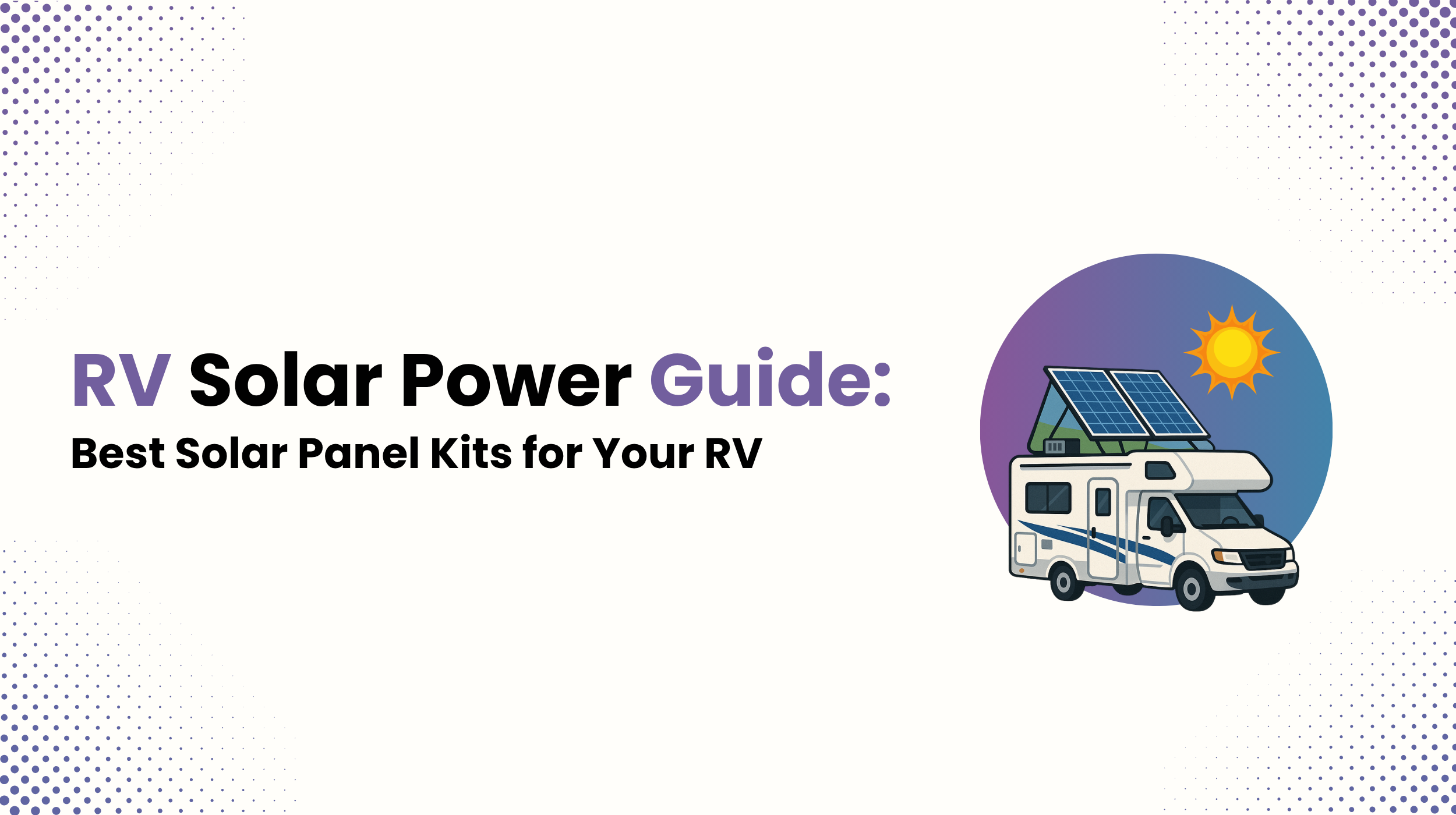Imagine pulling into a quiet forest clearing or a scenic desert plateau, away from noisy generators and crowded campgrounds, and still having power to run your essentials. That’s the promise of RV solar power: true energy independence. Boondocking, or camping without hookups, becomes easy and quiet when your RV’s roof is equipped with solar panels that charge your battery bank with sunlight.
Solar power allows RVers to save money over time, especially when compared to the fuel and maintenance costs of generators. It’s silent, emission-free, and perfect for travelers who want to reduce their environmental footprint. Most importantly, it provides peace of mind by providing power without relying on hookups or the grid.
The Core Components: What’s Actually in an RV Solar Kit?
An RV solar kit consists of more than just a panel mounted on the roof. While configurations may vary, most kits include four main parts: solar panels, a charge controller, batteries, and an inverter. Let’s break down what each one does and why it matters.
Solar Panels: The Power Generators
Solar panels are the system’s front line. They absorb sunlight and convert it into direct current (DC) electricity. There are three common panel types:
- Monocrystalline panels are the most efficient. They perform better in low-light and high-heat conditions and are ideal for RVs with limited roof space. They’re also more expensive.
- Polycrystalline panels are slightly less efficient and bulkier but usually cost less, making them a solid mid-range option.
- Amorphous panels, sometimes called thin-film, are lightweight and flexible, but far less efficient. They’re mostly phased out except for specific portable use cases.
Panels also differ in form factor. Rigid panels are standard for permanent roof installations. Flexible panels are good for curved surfaces, and portable suitcase panels are great if you want to park in the shade and position the panels in the sun.
Charge Controller: The System’s Brain
Without a charge controller, your batteries could be overcharged and damaged. The controller regulates energy flow from your panels to the battery bank.
There are two main types:
- PWM (Pulse Width Modulation) controllers are basic and affordable but less efficient.
- MPPT (Maximum Power Point Tracking) controllers cost more but can boost efficiency by up to 30%, especially in cold temperatures or with partially charged batteries.
For most RVers investing in a full kit, MPPT is the better long-term value.
Battery Bank: Your Energy Reservoir
Your batteries store solar power so you can use it at night or when it’s cloudy. Choosing the right battery affects everything from how long you can camp to how often you need to recharge.
- Lead-acid batteries, particularly AGM, are affordable and widely used. They’re sealed and maintenance-free, but heavy and limited in how much energy you can safely draw (50% discharge recommended).
- Lithium-ion (LiFePO4) batteries are lighter, last significantly longer, and allow deeper discharge (up to 90%). They cost more upfront but save money in the long run.
Power Inverter: From DC to Household AC
Most RV appliances, such as laptops, coffee makers, and microwaves, operate on standard 120V AC power. Since your battery bank stores DC, you will need an inverter to convert it.
- Pure sine wave inverters produce clean, consistent power that is safe for sensitive electronics.
- Modified sine wave inverters are cheaper but can damage or disrupt some devices.
Sizing Your System: How Many Solar Panels Do You Really Need?
Sizing your solar setup is more straightforward than it sounds. All it takes is some math and a good understanding of your daily energy use.
Step 1: Conduct a Power Audit of Your RV
Start by listing the appliances you want to run and how long you use them daily. Then multiply each item’s wattage by the hours of use to get watt-hours per day.
Example Table:

Step 2: Calculate Your Solar Panel Wattage
A 100W panel generates about 350–400 watt-hours per day in real-world conditions. To calculate your required wattage:
Daily Use (Wh) ÷ 3.5 = Panel Wattage Needed
Using our example: 1640 ÷ 3.5 = ~470 watts. So you’d want around 500W of solar panel capacity.
Step 3: Determine Your Battery Bank Capacity
Match your battery capacity to your daily watt-hour needs, ideally with some backup for cloudy days.
Remember:
- Lead-acid batteries should only be used to 50% capacity.
- Lithium batteries can safely go to 80-90%.
If you use 1600Wh per day, you’ll want:
- 3200Wh of lead-acid storage (about 270Ah at 12V).
- 2000Wh of lithium storage (about 170Ah at 12V).
The 5 Best RV Solar Kits for Every RVer in 2025
Now that you understand your needs, here are the best solar panel kits to consider based on real-world use cases.
Renogy 400W Solar Kit: Best Overall System
- Best For: Most RVers looking for reliable, expandable power
- Includes: 4 x 100W Monocrystalline Panels, 40A MPPT Controller, Mounting Hardware, Adapters
- Pros: Great brand reputation, expandable, solid tech
- Cons: Doesn’t include batteries or an inverter
Renogy is the gold standard for RV solar gear. This 400W system is powerful enough for part-time or full-time boondockers with moderate energy needs.
Go Power! Weekender ISW Kit: Best for Weekend Warriors
- Best For: Short trips, part-time RVers
- Includes: 190W Panel, 30A PWM Controller, 1500W Pure Sine Inverter
- Pros: Easy to install, comes with a quality inverter
- Cons: Limited panel wattage, not ideal for high usage
Go Power! delivers a reliable plug-and-play system that keeps your batteries topped off while running lights, fans, and small electronics.
Zamp Obsidian 90-Watt Portable Kit: Best Portable ‘Suitcase’ Kit
- Best For: Small rigs, vanlifers, supplemental power
- Includes: 90W Obsidian Panel, Built-in 10A Controller, Foldable Kickstand
- Pros: Lightweight, no roof drilling, quick setup
- Cons: Low wattage, best as a secondary option
Zamp’s Obsidian panel is durable, sleek, and extremely easy to deploy. It’s perfect for RVers who chase the sun and want mobility over fixed setups.
Complete Kit with Inverter & Battery: Best for Full-Time Boondocking
- Best For: Full-time RVers, heavy power users
- Example Kit: BougeRV 600W Complete Off-Grid Solar System
- Includes: 600W Panels, 60A MPPT Controller, 200Ah LiFePO4 Battery, 2000W Pure Sine Inverter
- Pros: All-in-one, runs larger appliances, supports longer stays
- Cons: High upfront cost
This type of setup is for the serious traveler. With enough juice to run a microwave or even an AC unit briefly, it’s an all-inclusive package designed for independence.
ECO-WORTHY 200W Kit: Best on a Budget
- Best For: Newbies or minimalist power users
- Includes: 2 x 100W Panels, 30A PWM Controller, Cables, Mounting Z Brackets
- Pros: Affordable, solid performance for the price
- Cons: Basic components, not expandable
If you want to start small or just maintain your batteries, ECO-WORTHY’s kit offers unbeatable value without sacrificing reliability.
Frequently Asked Questions About RV Solar
What size solar panel do I need just to maintain my RV battery?
To maintain or trickle-charge a 12V battery, a single 50W–100W panel is usually sufficient. It’s ideal for RVs in storage or for minimal draw situations.
What is the 120% rule for solar panels?
This National Electrical Code rule means the total of your solar breaker and main breaker shouldn’t exceed 120% of your electrical panel’s rating. It mainly applies to grid-tied systems, but RVers using shore power should be aware of it.
How much does it cost to install an RV solar system?
Expect to pay $300–$800 for small portable kits, $1,000–$1,500 for mid-sized DIY roof systems, and $3,000+ for full-time setups with lithium batteries and inverters. Don’t forget: the 30% federal solar tax credit can apply to your RV if it qualifies as a second home.
Do I need a generator if I have solar panels?
It’s smart to have a generator or shore power backup. Solar power depends on the sun; overcast conditions or high power usage can drain your batteries. Many RVers use both solar and generator systems together for flexibility.
How to install and mount solar panels on an RV?
Installation varies by kit, but most roof-mounted systems require:
- Cleaning and prepping the roof
- Drilling and sealing mounts (or using adhesive mounts for flexible panels)
- Running wiring to the charge controller and battery bank
- Mounting the controller inside the RV
- Connecting the inverter if AC power is needed
Is an RV Solar Kit Worth the Investment for You?
A solar kit can be a game-changer for weekend campers seeking to avoid hookups, as well as for full-time travelers desiring off-grid freedom. It provides quiet, clean energy with lower long-term costs compared to generators, and it opens up camping options well beyond standard RV parks.
Start by understanding your energy needs, then choose a system that aligns with your lifestyle. Whether you want a small portable setup or a full-time powerhouse, there’s an RV solar panel kit that fits your journey.
Your RV. Your adventure. Now powered by the sun.

